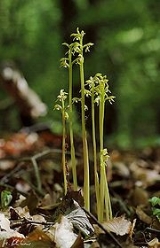
Corallorhiza trifida
Encyclopedia
Corallorhiza trifida, commonly known as early coralroot, northern coralroot, or yellow coralroot, is a coralroot orchid
native to North America
and Eurasia
, with a circumboreal
distribution.
, deriving some, but not all of its nutrients from association with fungi
of genus Tomentella
. It also contains chlorophyll
, with which it supplies some of its own carbon
nutrition via autotrophy
.
Corallorrhiza
Corallorhiza, the coralroot orchids, is a genus of flowers in the orchid family. Most species are leafless, relying entirely upon symbiotic fungi within their coral-shaped roots for sustenance...
native to North America
North America
North America is a continent wholly within the Northern Hemisphere and almost wholly within the Western Hemisphere. It is also considered a northern subcontinent of the Americas...
and Eurasia
Eurasia
Eurasia is a continent or supercontinent comprising the traditional continents of Europe and Asia ; covering about 52,990,000 km2 or about 10.6% of the Earth's surface located primarily in the eastern and northern hemispheres...
, with a circumboreal
Circumboreal Region
The Circumboreal Region is a floristic region within the Holarctic Kingdom in Eurasia and North America, as delineated by such geobotanists as Josias Braun-Blanquet and Armen Takhtajan....
distribution.
Description
Corallorhiza trifida is yellowish green in color, leafless, and partially myco-heterotrophicMyco-heterotrophy
Myco-heterotrophy is a symbiotic relationship between certain kinds of plants and fungi, in which the plant gets all or part of its food from parasitism upon fungi rather than from photosynthesis. A myco-heterotroph is the parasitic plant partner in this relationship...
, deriving some, but not all of its nutrients from association with fungi
Fungus
A fungus is a member of a large group of eukaryotic organisms that includes microorganisms such as yeasts and molds , as well as the more familiar mushrooms. These organisms are classified as a kingdom, Fungi, which is separate from plants, animals, and bacteria...
of genus Tomentella
Tomentella
Tomentella is a genus of corticioid fungi in the Thelephoraceae family. The genus is ectomycorrhizal, and widespread, with about 80 species. It was circumscribed by Narcisse Théophile Patouillard in 1887.-Species:*T. angulospora*T. asperula...
. It also contains chlorophyll
Chlorophyll
Chlorophyll is a green pigment found in almost all plants, algae, and cyanobacteria. Its name is derived from the Greek words χλωρος, chloros and φύλλον, phyllon . Chlorophyll is an extremely important biomolecule, critical in photosynthesis, which allows plants to obtain energy from light...
, with which it supplies some of its own carbon
Carbon
Carbon is the chemical element with symbol C and atomic number 6. As a member of group 14 on the periodic table, it is nonmetallic and tetravalent—making four electrons available to form covalent chemical bonds...
nutrition via autotrophy
Autotrophy
Autotrophy is the ability to be self-sustained by producing food from inorganic compounds. Some bacteria and some archaea have this ability. Inorganic compounds are oxidized directly without sunlight to yield energy. This metabolic mode also requires energy for CO2 reduction, like photosynthesis,...
.

